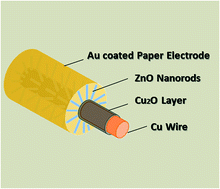Flexible piezoelectric nanogenerator based on Cu2O–ZnO p–n junction for energy harvesting
Abstract
In this study, a nanogenerator based on Cu2O–ZnO p–n junction has been fabricated on Cu wire substrates for harvesting mechanical energy from the environment. The flexible nanogenerator is composed of a Cu substrate, a Cu2O layer, ZnO nanorods and an outer Au-coated paper electrode; the Cu2O layer was obtained by oxidizing Cu wires directly and the ZnO nanorods were grown on the Cu2O layer using a low-temperature hydrothermal method. The existence of the Cu2O–ZnO p–n junction makes a contribution towards reducing the number of excess electrons in the ZnO, which facilitates in improving the output signal and also overcomes short circuits. An Au-coated paper electrode can involve more nanorods in the power generation process. The DC output voltage was up to 42 mV and the maximum output current density was 400 nA, which are approximately a 13-fold higher voltage and a one order of magnitude larger current in comparison to devices without a Cu2O layer, respectively. This study may provide important insight into a facile fabrication method for low-cost and high-performance energy harvesting devices.


 Please wait while we load your content...
Please wait while we load your content...